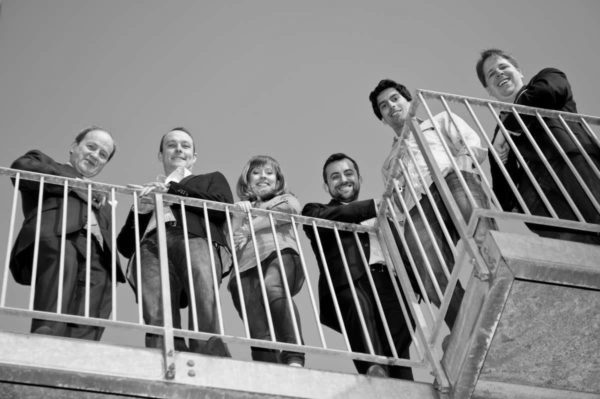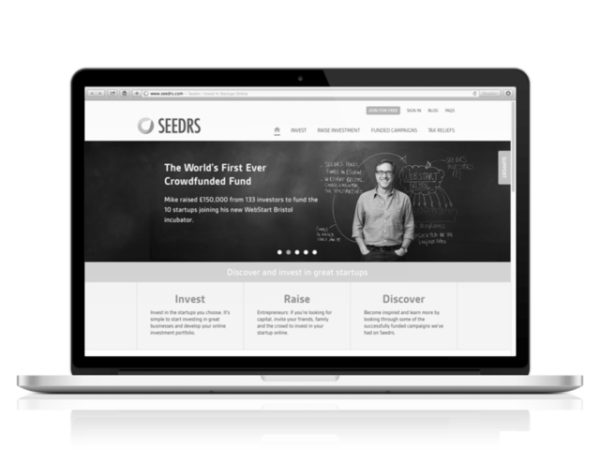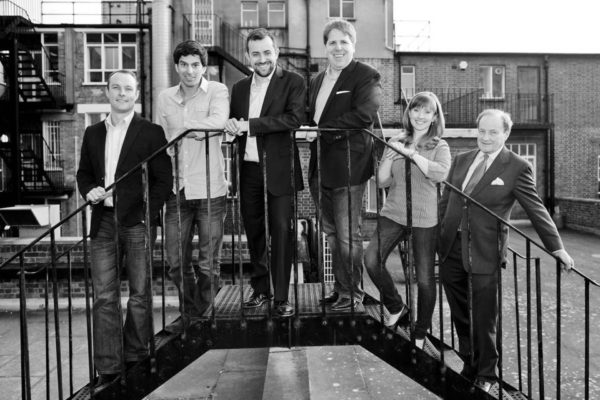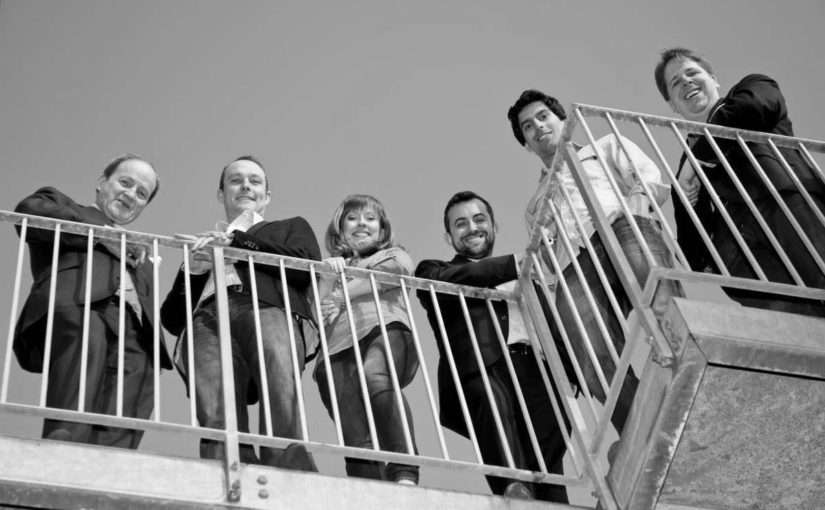Seedrs provides a tool that startups can use to raise capital from their friends, family, customers and the crowd. This process is often called “equity crowdfunding” because it’s like Kiva or Kickstarter, except that the investors get equity in the company instead of a product or a loan. In January 2014, I joined Seedrs as part of the marketing team.

At the end of last year, Seedrs raised 2.58 million pounds from over 900 investors using their own platform. That means that in my new marketing role, I now have over 900 bosses. I feel very accountable for the success and growth of the business. In this blog post, I want to share two main things about my new role, the expanded view of marketing that we’re taking at Seedrs, and the way that we’re incorporating lean manufacturing habits and processes into our team culture.
The Seedrs community of entrepreneurs and investors
The Seedrs approach is very effective and plenty of hot startups have used the platform as a tool to collect investment from their customers, fans and community. I met the team last year when Raj Ramanandi from Number 1 Seed introduced Klaus Bravenboer and I to Jeff Lynn based on our work with Ami Shipro and the Innovation Warehouse.
There is an established base of investors who already use the Seedrs platform (often on a daily basis) to spot new startups and add to their diversified portfolios. We need to continue to serve their needs, while constantly making the platform faster and easier to use for people who just want to contribute a small amount to a single startup.
In the future, equity crowdfunding will become the default way that new startups test the appetite for investment into their business. If you can convince your mum, former colleagues and a few customers to invest in your startup, then you will have learned a lot of information that you can take to an angel investor when it’s time for your next round of funding.

A Seedrs round is also a great way to get feedback on a new idea. Not sure whether a particular startup idea is good enough to quit your job for? Then create a Seedrs round and if it funds, then you have proven the market and will also benefit from a swarm of investors who can help you out with mentoring, connections, introductions and advice.
Even for bootstrapped businesses (who don’t really need investment), we’ve seen Seedrs rounds used to bind a community together by giving them shared ownership in the new company. We’re also seeing companies do multiple small rounds of funding as they grow and evolve. This allows them to demonstrate momentum and progress.
1. Marketing includes design thinking & growth hacking
At Seedrs, we view the remit of marketing as anything that helps the company to grow. This takes our team’s activities well outside the normal purview of marketing and communications.
Our real mandate is to deliver on the exponential growth aspirations of the Seedrs team (and the new Seedrs investors). Organic growth will continue to come from relationships, momentum and the great reputation that Seedrs has already built up. But finding the engine of exponential growth is the real focus for my team and I. We’re incorporating two new themes into our marketing activity:
- Design thinking is a key part of how we put the user at the centre of every marketing and product decision. Seedrs has a wonderful product that requires ongoing improvements to user interface, information architecture and user experience to make it as amazing as it can be. We’re constantly learning from our users and design thinking acts as the voice of the customer.
- Growth hacking is the modern term for blending many marketing disciplines together and also combining them with input into product development. In New Zealand, we called this expanded definition of marketing “branding” because the brand experience includes the product, positioning and reputation. But in Europe the term branding is still restricted to logos and graphics. Growth hacking acts as fuel on the fire by blending short, quick marketing experiments with rigorous testing, data and analytics.
My friend James Clark has been arguing for some time that marketing always included product, positioning and all of the things that we call design thinking or growth hacking. I’m inclined to agree and settled on the job title of Chief Marketing Officer, even though many people will underestimate how broad our team’s activities are.
2. Creating team culture through habits & systems
In future articles, occasionally on this blog and mainly on the Seedrs blog, I’ll be sharing the things that we learn from building a high-performance startup. I’m now responsible for a team of marketers, community builders, UX designers, graphic illustrators and digital product designers. Our R&D and product design teams are in Portugal, so I’m having to build new habits and structures to help us operate as a single team.
One culture hack that I’ve been using to implement Lean Startup ideas at Seedrs is to never have a meeting only once. If it’s worth getting more than two people together to discuss something, then it’s worth doing it regularly to keep on improving in this area. Over time, habits and systems beat flashy interventions.
In the last two weeks at Seedrs we have begun:
- Daily emails among our immediate team to let each other know what time we will be at work. Several of our team are constantly travelling and often running late night events, so start times are pretty casual in the office. Even so, it’s polite to let your immediate team know what time that you’ll be arriving. (2 mins)
- Daily use of Asana task management, shared Google Documents, Skype chats and shared Google Calendars. (Ongoing)
- Daily team work in progress meetings where each person updates the group with a couple of wins from yesterday (good to remind ourselves of), what they’re working on today (kicks in the power of public commitment) and how much capacity they have to help other people out (reinforces trust). (10 mins)
- Weekly team meetings for each of the key focus areas for continuous improvement. In which we discuss ways that a particular area of the business could be improved. (30 mins)
- Weekly team meeting to discuss priorities, plan the next week and bring up anything to do with workflow, resources and productivity. (1 hour)
- Monthly planning and review of priorities, resources and budget with the whole team. This also includes a creative session on new marketing ideas that cut across the business. (2 hours)
- Weekly product development prioritisation meetings with a representative from each of the technology, business and design teams (that’s me). That gives us a hacker / hustler / designer triangle based on innovation agency Ideo’s human centred deign structure of feasibility, viability and desirability. (1 hour)
One of my team commented that it feels like he’s spending much more time in meetings, but somehow getting more done than ever before. This is the force multiplier effect of clarity, communication and trust in the team.
Building trust within a startup team
In the spirit of radical transparency pioneered by Zappos and Buffer, I’m going to continue to share the nitty-gritty lessons that we learn from real life inside a startup. Everyone says that building a team culture is important but it’s not always easy.
While explaining some of our new processes, a team member warned me that “We need to stay flexible and agile, so maybe we will need to break the new processes occasionally.” It sounded like common sense, but something didn’t sit right with me. What I realised was that in a startup, every system and process exists to increase speed, agility and adaptability.
“We don’t have processes to decrease velocity, we have them to increase velocity.”
If you need to bend or break a process to achieve something faster or better, then the process itself wasn’t right in the first place and should be replaced by one that doesn’t need breaking. The metaphor that I’ve been using is that building culture through habits and process is like booting up a new computer:
- The daily emails and communication habits are like the BIOS or low level I/O systems. They allow for the smooth flow of factual information.
- The daily team meetings are like the operating system. They create the context for things to get done, provide fault tolerance and allocate resources.
- The weekly team meetings are like the device drivers and development stack. They serve to connect multiple applications together and process shared information.
- The individual human beings who physically go out and get things done are like the applications. They use the context of the BIOS, OS and drivers to get routine things out of the way, so that they can focus on whatever it is that they do best.
If a process, habit or system breaks, then we can reboot down to the lower level subsystem but whatever happens, we always have a free flow of information to build back up from.
Maintaining a startup culture as a company grows
In some regards, Seedrs itself is no longer a startup. It’s a successfully funded financial services business and has a wonderful team of nearly twenty people spread across multiple offices with a repeatable business model serving thousands of entrepreneurs and investors. On the other hand, Seedrs is the quintessential startup (and will remain so for quite some time). We’re fast growing, adaptable, creative and hungry. The market that we’re in is still so new and so disruptive that every day brings new uncertainties, competition and challenges. We’re a startup at heart and I wouldn’t have it any other way.

There are few new ways that you can help me out, now that I’m getting settled into my new role:
- If you’re an aspiring entrepreneur, you can use Seedrs to create a campaign and raise capital from your own community. Have a go and let me know on Twitter (or over coffee) how well the setup process works for you. My team and I personally help create mini-marketing plans for any startup that wants help raising funds from their community.
- If you’ve never invested in a startup before, then log onto Seedrs and invest £10 into an interesting startup. Try the system out and let me know how well the investment side of the platform works for you.
- If you’re a marketing, growth hacking, PR or branding professional then I’d love to hear what you think that we can do to grow the Seedrs brand. I’m putting everything that I’ve got into this and I’d love any help that I can get from my friends to make Seedrs insanely great.
This is my dream job. We’re building a tribe of companies that each have their own tribes of investors. I’m committed to serving our team, our investors and our community. I believe the best marketing and product ideas come from listening intently to users. So my ears are wide open.

Peter, I’ve been following your journey to seedrs and am delighted you have arrived in a place that will allow you to draw on all your skills and experience to make a difference. I run a company with nowhere near the ambition for high speed growth. An intentional, personal choice. But I will be happy to toss my two bob’s worth of gratuitous advice along the way and if any of my observations are of use then that’s great.
The first thing I really like about your outline is the integration of design thinking into your marketing. You’re right that has always been a part of marketing (audience segmentation/persona development) but it’s a great way to institutionalize an approach that is customer need first and anti “features and benefits”. I agree with you on branding. In Australia we treat it the same way as you Kiwis so I will leave you to deal with another realm of definition. Personally, I don’t like “growth hacking” term and prefer branding but there you go. One of your challenges is to get clarity from not only your team but your customers so consistent nomenclature will be important.
Your engagement/meeting cadence mirrors our approach. It works well. But only today, I had one staff member question why we need such a long weekly meeting. Don’t shift on that. As a leader, I like to talk through everything on our book. Insights spark, and other benefits from taking the time to give your team clarity. As you have identified, habits and processes are the king and queen of effective performance. You have to have the time to talk things through, particularly as you are getting started.
You also have the additional burden of building a team in multiple locations. Culture is an interesting beast and I think you do need to take the time as a team to create a vision, mission and values. I know it’s cliche and can be seen as a bit naff but I find it really helps to give you a shared shape and some ground on which to agree around behaviour. Having such a diversified team will be a big challenge so having an anchor, particularly around defined behaviour will be important. Stating a value such as ‘courtesy’ or ‘respect’ is just part of the job. You have to define what those values mean, agree on them and reward or punish behaviour that is inconsistent. People need to be able to have the freedom to be themselves and express their creativity but you have to have a framework and some discussion about what each value means. This takes time, so be prepared for some bumps along the way.
In terms of growing your new enterprise, great content created with passion, distributed with wisdom and measured with rigour will be crucial to telling your story and achieving the types of behaviour you want to see in your target audiences. The world is on the grid (or at least your potential client base are) and we are all connected. It’s valuable, relevant content (of all types), published on different platforms and in the places where your audiences are gathered that can make a massive difference. Don’t forget the traditional media (and their largish online audiences), but focus on using your design thinking principles to build accurate personas of potential clients who will subscribe to your content directly. Build your own audience on your own platforms one interaction at a time.
The other thing that I got from your article is that you are in a hurry to achieve exponential growth. Hasten slowly. Build the company on the 1,000 year clock. Make decisions for the future. Look after yourselves mentally, spiritually and physically. It will all turn to shit if you turn yourselves inside out.
You all look smiling and happy on the bridge. The challenge will be to keep it that way. Maybe print the photo out and put it on your desks to remind yourselves of how you felt in your early days. Ask yourselves ‘why are we smiling”? And write it down. If your metaphorical billie cart is not prepared to run at a million miles an hour down the hill, perhaps wait until it’s ready to do so. Final piece of advice, which you already know, is to be intensely human. Share the good, share the bad and share the indifferent. People will love you for your honesty and authenticity. Best of luck from an interested Aussie.
Ps. I also feel obliged to help out our English friends out after the toweling we gave them in the cricket this summer. The misery ended last night for all of us.
“We’re building a tribe of companies that each have their own tribes of investors.” – That’s what it is all about. Seth Godin managed to write a whole book about this and maybe you will one day.
After 300 equity raises, and seeing countless campaigns and platforms fail, I’ve come to the conclusion that building tribes is what it is all about. Expecting an offering to fill by expecting grazing investors to simply discovering it through serendipity has been the death of many.
Hi Paul, funnily enough I did write a book about building tribes. It’s not as widely read as Seth Godin’s work so you’re forgiven for not having heard of it. But it focuses on community building for tech companies so several startups have used it to raise capital. You can read a sample on my book page.
Just bought a copy.
Thanks.
http://www.amazon.com/tickle-social-media/dp/B00ECIJPSE/?tag=petjtho-20
Liked …
“If you can gently tickle your most important sales prospects with a targeted campaign of content creation and relationship building, then you will never need to make a cold call again!”